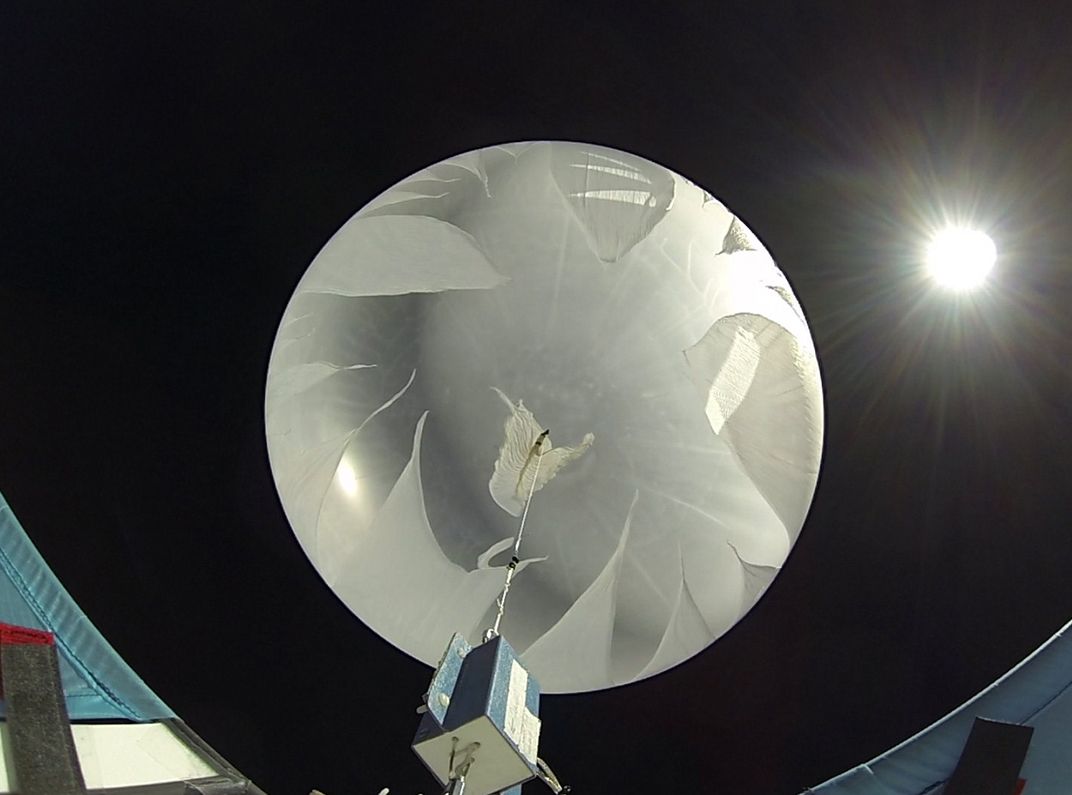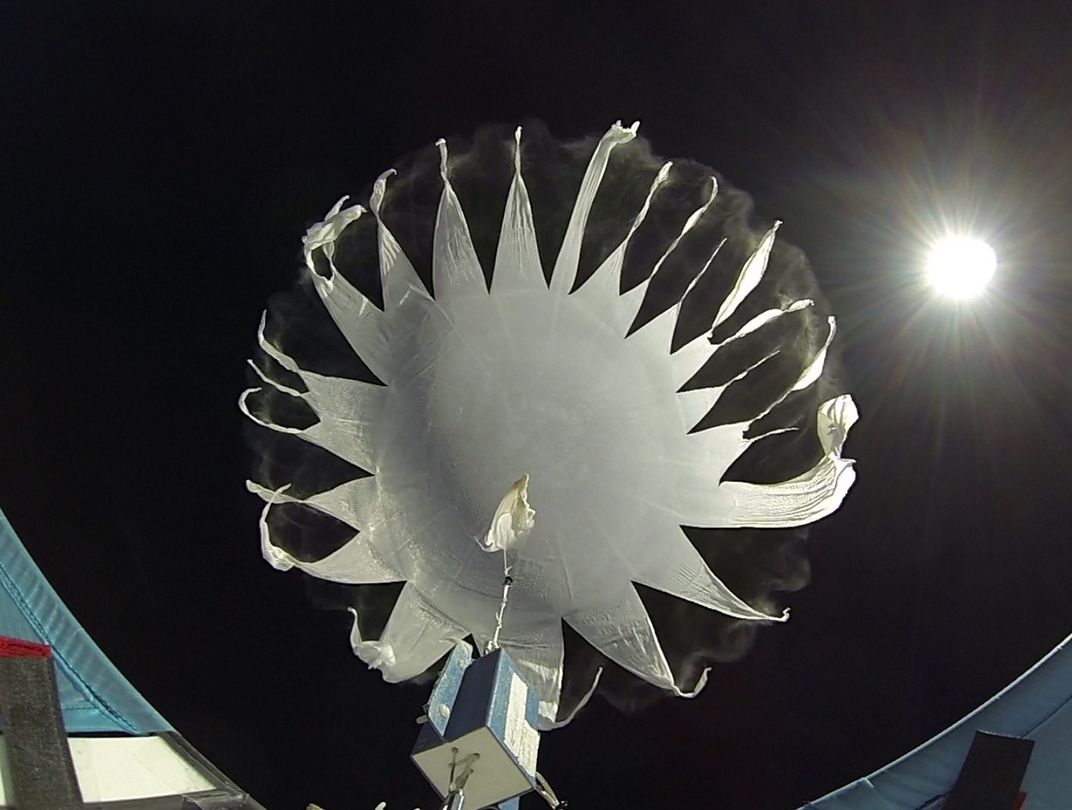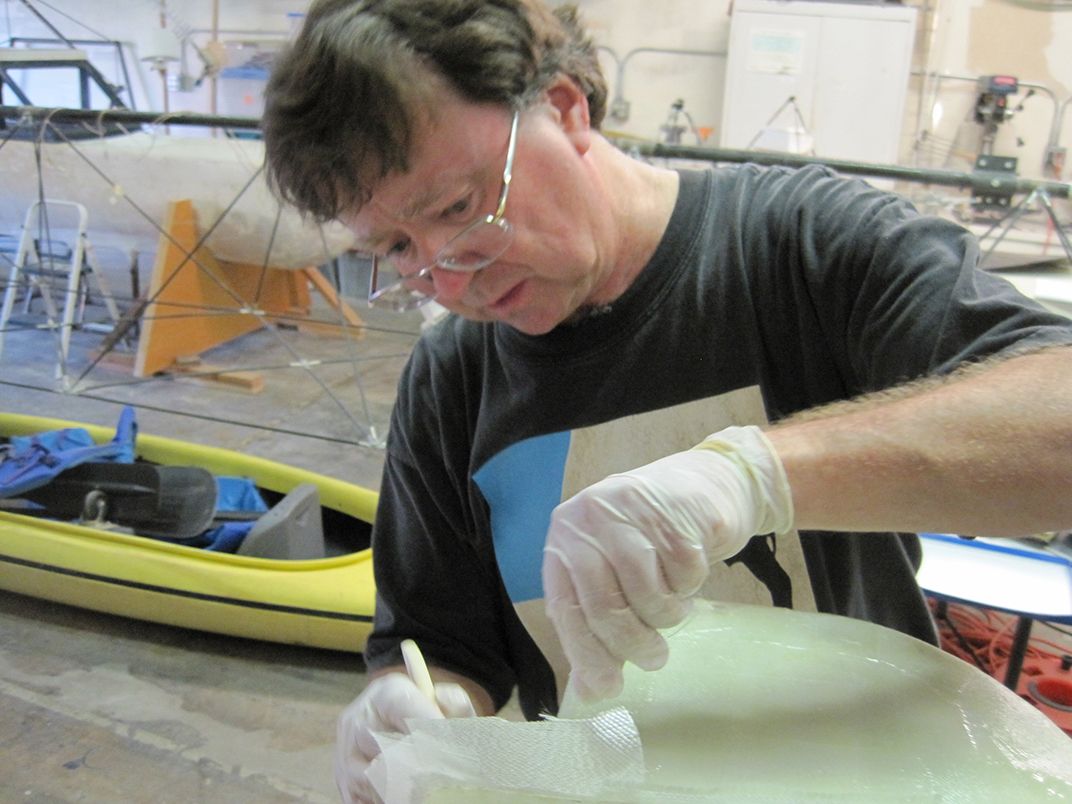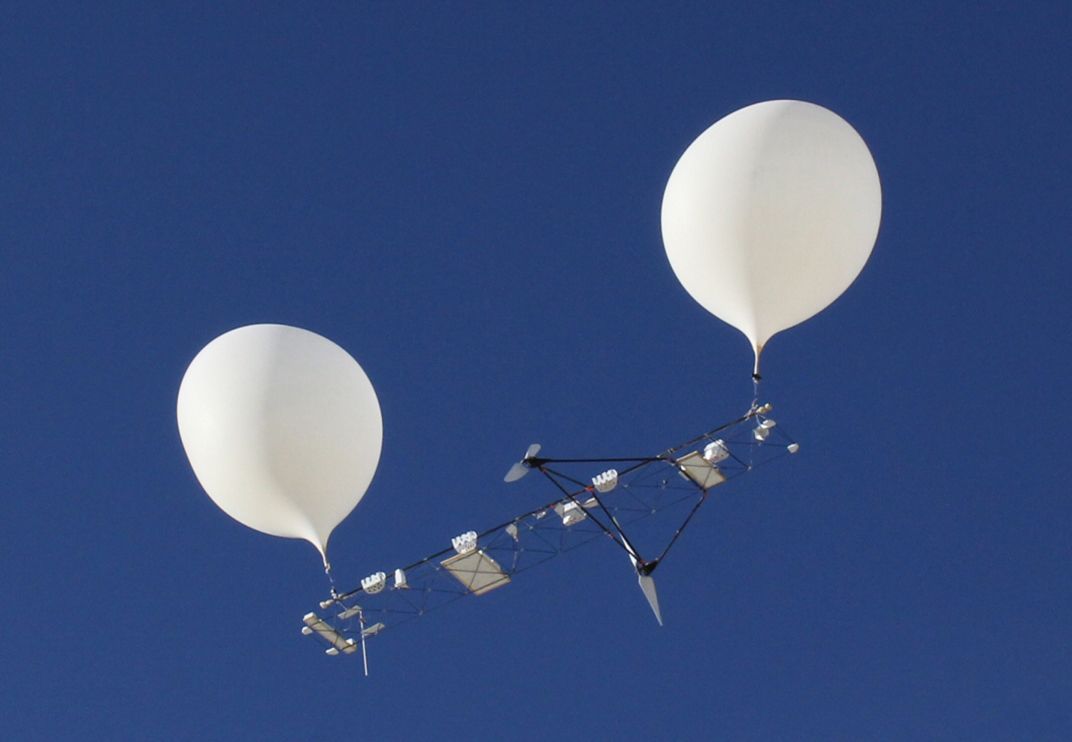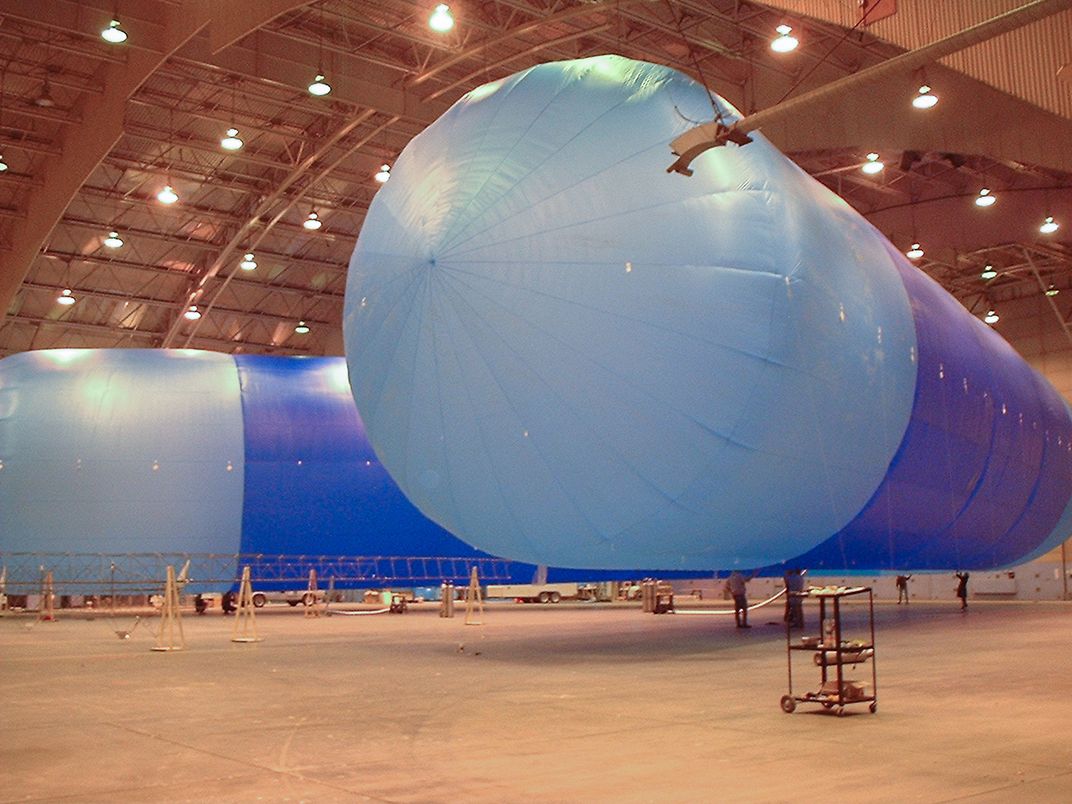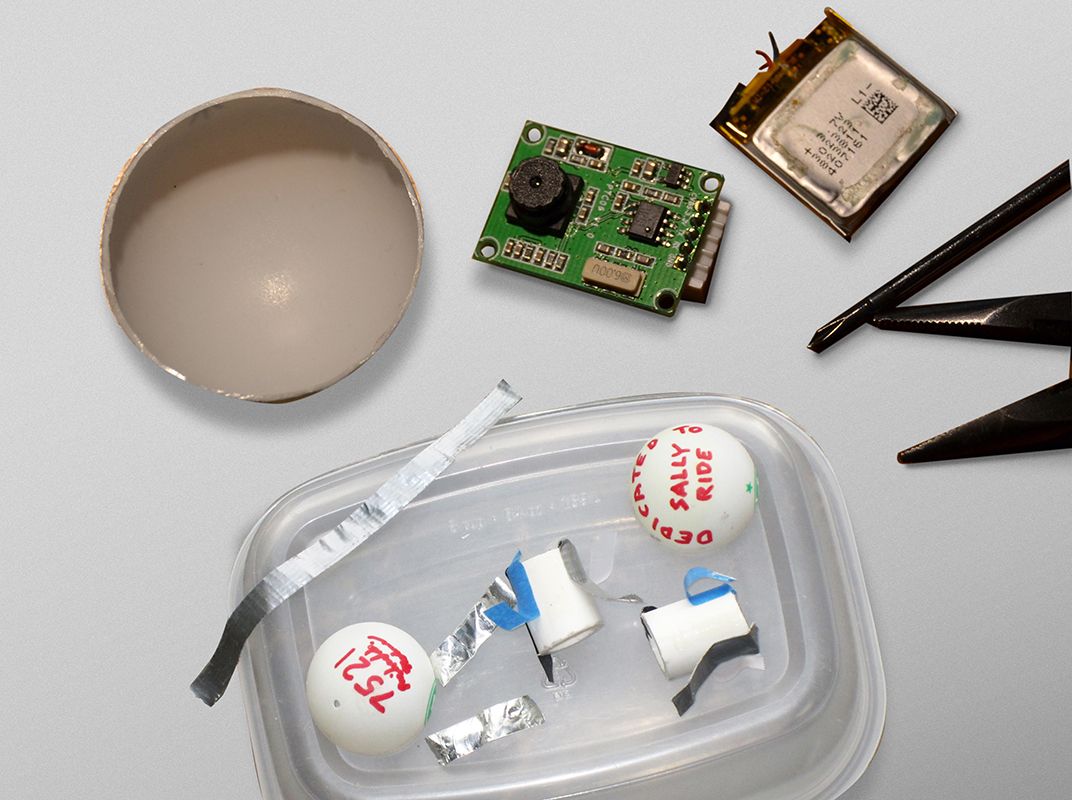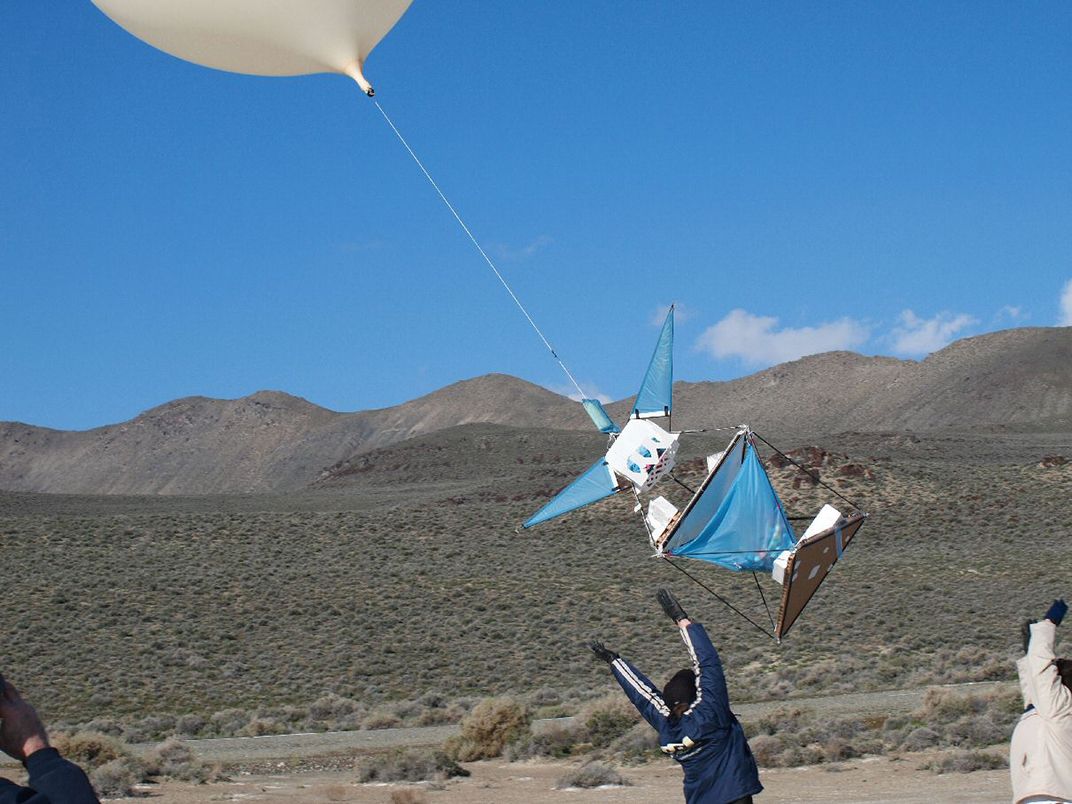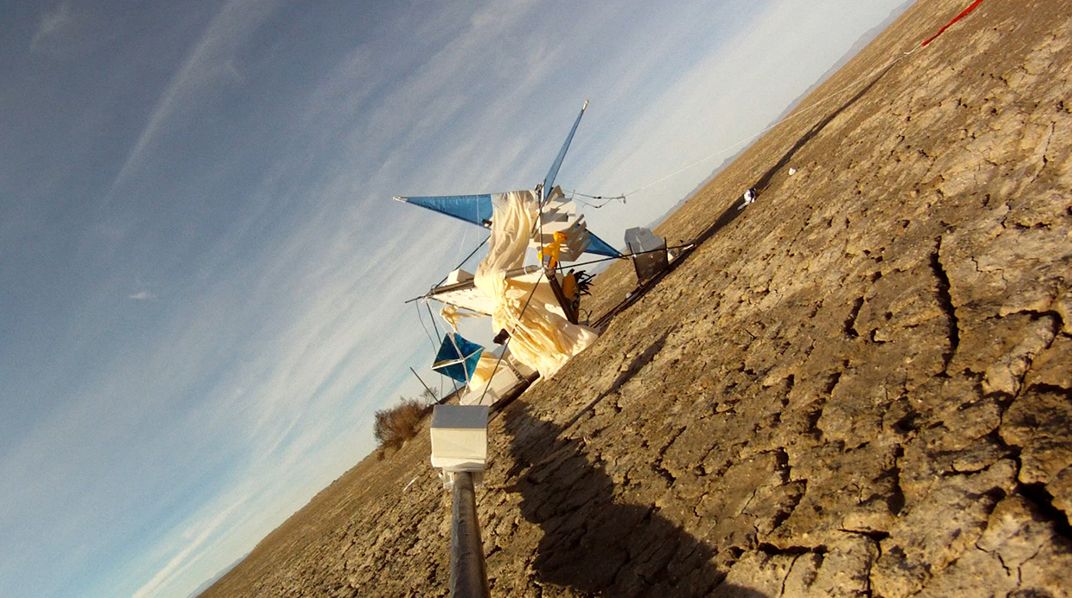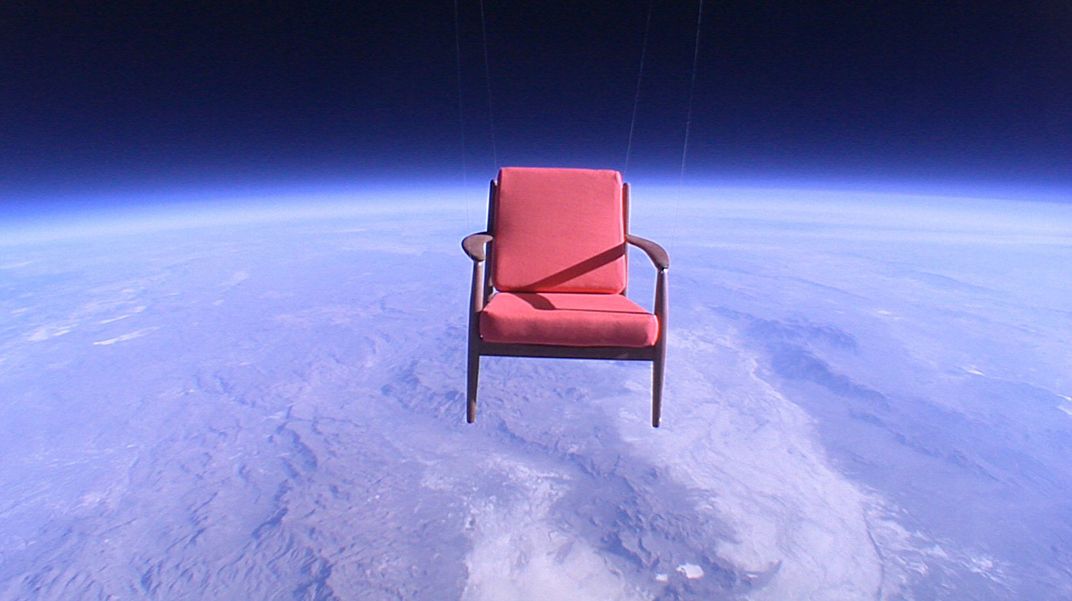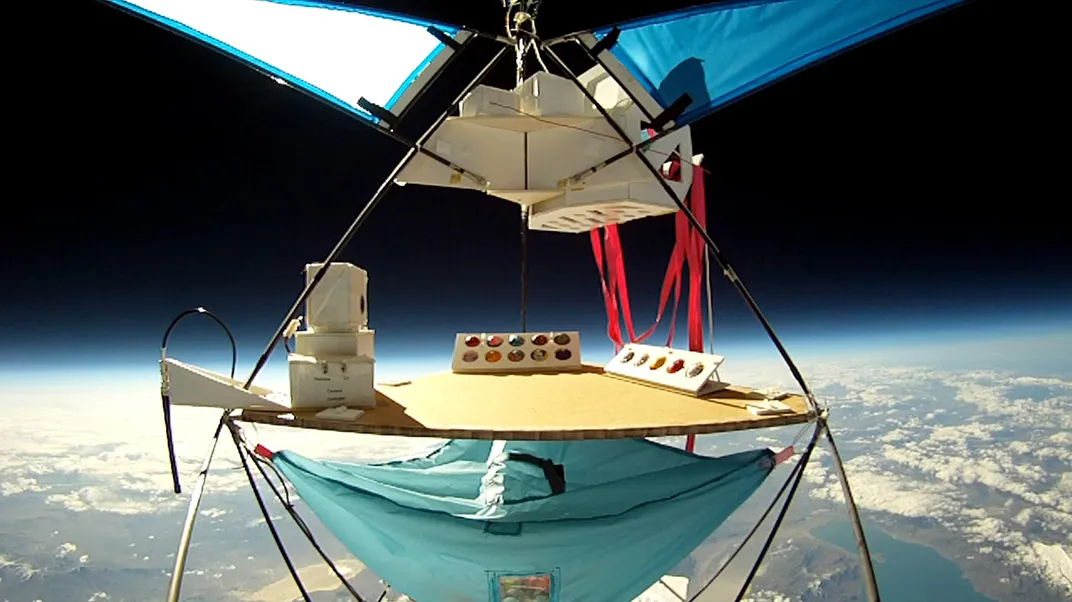To Space (Okay, Near-Space) in a Balloon
A little company dreams of replacing rocket power with buoyancy.
/https://tf-cmsv2-smithsonianmag-media.s3.amazonaws.com/filer/b4/f3/b4f3f652-647b-4975-bf70-13270af23694/09-jp-aerospace-mainimage.jpg)
The translucent ping-pong ball, equipped with GPS unit, tiny camera, and an interface to enable communication with the ground, had already travelled more than 5,300 miles, from Southampton, England, to California. Now, it was ready for a ride to the upper reaches of the stratosphere, where it would be reborn as a PongSat.
Along with several hundred others, it sat nested in a “high rack”—a spindly construction bristling with cameras, antennas, Styrofoam boxes, blue fabric fins, and a parachute. On a frigid Saturday before dawn in April 2013, five high racks, holding a total of nearly 2,000 PongSats, rested in Nevada’s Black Rock Desert. Soon, a helium-filled balloon would carry each rack 100,000 feet into the stratosphere.
Through the PongSat (short for Ping-Pong satellite) program, anyone anywhere can create a scientific experiment, as long as it fits inside a Ping-Pong ball, that will be flown to the stratosphere, retrieved, and returned—free of charge—along with flight information, a flight video, and a certificate of participation. Some contain tiny micro-processors, cosmic-ray counters, or telemetry systems. Others come from schoolchildren: boxes of PongSats with lists of their contents—M&Ms, crayons, a daisy. Some include a scientific hypothesis in the form of a question: “Popcorn kernels (Will they pop?)”; “Mini-marshmallow (Will it expand?).”
Some programs charge over $200,000 for scientists to conduct experiments in space. PongSat embodies John Powell’s belief in access to near-space science for everyone. For over 30 years, Powell and his all-volunteer group, JP Aerospace, have connected ordinary people with space. They accomplish this by shrinking the size of the experiment, sending it up with balloons instead of rockets, and settling for a trip to 100,000 feet—19 miles (space begins at around 62 miles). And by piggybacking the racks onto flights paid for by customers needing to launch commercial or research payloads.
Powell, 50, has an air of good-natured, guileless enthusiasm. When he was 17, he and three friends bid on a NASA contract. “We just thought if you want to win a NASA contract to build spaceships, you write the proposal, they give you money, and you go and build spaceships,” he says. The competing bids were winnowed down to four, including Lockheed, Grumman Aircraft, a third Powell doesn’t remember, and Powell’s company. They didn’t win the contact, but the near-win launched JP Aerospace.
In 1983, Powell, studying physics at the University of California at Davis, had to drop out and work full time. Rather than explain that when corporate and Air Force officials ask him where he got his doctorate, he answers, “I am a high school graduate.” It’s part of the pride he takes in his unconventional aerospace operation.
Powell likes to inspire a fascination with science and space in children and teenagers, but his influence has reached beyond those age groups. The late Arthur C. Clarke, author of 2001: A Space Odyssey and table-tennis maven, enjoyed trouncing guests at his home in Sri Lanka with balls flown on JP Aerospace missions.
Powell funds PongSat flights with other projects: The company has flown payloads for the Discovery Channel, National Geographic, the states of Texas and California, Lockheed Martin, and other aerospace firms. A big contract in 2009 produced a spectacular high-definition commercial for wide-screen televisions (viewable on YouTube); it shows an armchair seeming to float to an altitude of over 90,000 feet, where it hovers in blackness. In July 2011, Samsung came calling for the rollout of a new cellphone. Courtesy of JP Aerospace, hundreds of thousands of people around the world watched online as their text messages and pictures were displayed on an example of the new phone floating in the stratosphere. More recently, JP Aerospace has flown ads for Lenovo laptops, KLM airlines, and a Colombian hamburger franchise. The group has launched more than 150 flights, using rockets, high-altitude balloons, and rockoons—rockets carried aloft by balloons and launched at high altitude.
Powell rejects investment capital, believing it would subvert the goals of his program, which include gradually developing balloon-lofted manned flights into near space. He has used Kickstarter to fund flights, offering small gifts in return for donations. One Kickstarter campaign raised over $11,000 for a 2012 PongSat flight. And the group brings in money doing the kind of small-scale work that makes it the aerospace equivalent of the neighborhood handyman: “If the Air Force needs a widget and they need it in six months and they don’t have a billion dollars,” says Powell, “we’ll get this call saying ‘JP, can you make this for me?’ And we’ll do that and maybe get rent paid for a year.”
Powell’s aerospace team is unique. There is no paid staff, no PR department, no lobbyist. The headquarters could fit in one of Lockheed Martin’s utility sheds. “We’re the slowest aerospace program in history,” Powell says. “Think big by thinking small.”
Powell’s office, in an industrial park east of Sacramento, California, looks like a cross between the headquarters of a modest non-profit and the bedroom of a boy in love with flight. A small bookcase holds titles on aerodynamics, polymer dynamics, and electric propulsion, along with Patent It Yourself (Powell has one big patent, for lighter-than-air orbital vehicles, and three others nearing approval) and Sneakier Uses for Everyday Things.
Yet JP Aerospace has managed to solve some of the problems of working in near-space that have stymied large, well-funded organizations. For example, the Air Force spent two decades and $4 billion trying to develop a propeller that would work in the airlessness of space, and still failed. JP Aerospace cracked the challenge in just three months and with only $5,000. The company relied on the aerodynamic distinction between “laminar” and “turbulent flow.” With laminar flow, the layers of the fluid slide past each other like a deck of cards; they don’t separate from the surface. With turbulent flow, they create eddies that ricochet off one another. Because the performance of an airfoil with laminar flow is vastly superior, Powell says, “everyone’s chasing the laminar-flow propeller at 100,000 feet…. A turbulent-flow propeller will work badly at 100,000 feet, but a laminar-flow propeller that’s not doing laminar flow doesn’t work at all.”
Powell’s propellers were put to the test in October 2011, when JP Aerospace’s tandem-balloon vehicle set a new absolute altitude record for an unmanned airship. The previous record was set by the U.S. Army Space and Missile Defense Command, which in 2005 sent its HiSentinel airship to 74,000 feet—14 miles.
JP Aerospace’s Tandem looks like something made with a giant erector set. The 27-foot-long carbon-fiber frame, stocked with cameras, tracking devices, and parachutes, is lifted by a high-altitude balloon on each end and sports two of those turbulent-flow propellers, powered by electric scooter motors. It cost $30,000 to produce—and fully loaded weighs only 60 pounds. On its record flight, it made a smooth liftoff from the Black Rock Desert, then weathered the turbulence of the jetstream as team members radioed signals to fire the propellers in short bursts that would prevent freezing. When the airship passed the Army’s 74,000-foot mark, the ground crew cheered. Video from onboard cameras (on YouTube, search on “World’s Highest Airship”) shows the craft turning, flying forward, and flying in reverse in response to commands sent to the propellers. In the thin air at 95,085 feet, the helium in one of the balloons had expanded so much that the balloon exploded, as planned. Powell sent a command to detach the other, and the vehicle descended under its five parachutes, landing safely.
***
Powell’s ultimate goal is to fly humans into Earth orbit. The three-stage system he envisions for that mission, the Airship to Orbit (ATO), seems far-fetched, even outrageous. A ship light enough to float to an altitude from which it could be accelerated into orbit would first be torn apart by the weather systems in the lower atmosphere, according to Powell. One strong enough to survive them would be too heavy for the final voyage into orbit. His solution is a system with three separate airships. The first stage would be as long as three 737s, the final stage would stretch over a mile, and his middle stage would measure three miles across and permanently hover 26 miles above Earth’s surface. (The immense size of the vehicles serves to maximize lift.) All three airships would employ the same design—multiple gas-filled lifting cells that are contained by an inflated outer fabric shell, strengthened by lightweight carbon-fiber keels.
The first-stage, the V-shaped Atmospheric Ascender, would float up to 140,000 feet. Powell actually built a 175-foot-long version of the Ascender for the Air Force—with disastrous results. The military wanted a reconnaissance vehicle that could fly at 100,000 feet undetected by radar, but disregarded weather warnings and insisted on a demo launch in what became an actual tornado. The vehicle was destroyed.
At 140,000 feet, the Atmospheric Ascender would dock with the second stage, the Dark Sky Station (DSS), named for the sky’s darkness at that altitude. Shaped like a starfish and using buoyancy from the gas-filled cells to stay parked in the thin atmosphere at that altitude, the DSS would serve as airport, warehouse, construction site, and launch site for the third stage: the Orbital Ascender. The Ascender would float up to 200,000 feet, where, in the absence of even minimal atmosphere for lift, it would switch to an alternative energy source for propulsion—Powell thinks a hybrid engine using both chemical and ion propulsion. (Ion engines have been used since the late 1990s to power satellites and exploratory spacecraft.) During this final leg of the journey, which would take about five days, like a leisurely ocean voyage, the Orbital Ascender would gradually accelerate to the speed needed to achieve a stable orbit around Earth. For the return trip, the sequence would be reversed.
Aerospace experts believe that ATO won’t work, arguing that it is physically impossible for Powell’s third-stage airship to reach orbit. Considering weight, mass, velocity, and whatever drag the thin atmosphere at that altitude produces, John Jurist, an adjunct professor in aerospace studies at the University of North Dakota, concludes, “It’s an interesting idea, but when you start actually putting the numbers to it, it just doesn’t appear to work. The acceleration to orbital speed is the killer.”
Most observers assume that, if the laws of physics don’t defeat Powell, his financial-organizational model will. They believe that building ATO would require scaling up operations to include full-time paid staff and funding in the hundreds of millions.
For now, Powell works exclusively with a team of volunteers. “The team is everything,” Powell says. “It’s not me or the engineering, the money, or the science. If the team is working, everything is possible. If you don’t have a working team, you’re not going to get across the street, let alone to space.”
About 200 people have worked with JP Aerospace at one time or another. Anyone can volunteer, but, after a six-month trial period, each novice needs five active members to vouch for him or her in order to become a regular member. Powell handles all fundraising and regulatory paperwork, so the volunteers can put all their time into hands-on work.
They come in on Saturdays and Tuesday evenings, and they devote more time as flights approach. Why the sacrifice? For many, a major draw is hands-on involvement in a space project with visible results. Anthony Gregory, an electrical engineer who has worked with JP Aerospace for three years, put it this way: “I want to see something happen in my lifetime. I like to get in and work some little piece out and make it work with the big picture in mind.” Being part of the team also provides a powerful sense of camaraderie and connects team members to space. Unlike thousands who, when the shuttle program ended, had to abandon their dreams of working in the space field, JPA volunteers feel they are in the game. And this is Powell’s dream—ordinary people directly engaged with space.
JP Aerospace’s strengths are also its weaknesses. Its bantam size, rejection of investment capital, and reliance on volunteers have sustained it for decades and nurtured the operation’s knack for speed, frugality, and improvisation. On the other hand, the small group cannot at this point compete with big aerospace companies—SpaceX, Sierra Nevada, Boeing—that have the resources to create next-generation manned spacecraft.
Still, Powell has accomplished something satisfying: He has created a long-running and most unusual aerospace company, one that welcomes anyone who is interested. Through JP Aerospace, hundreds of people have been able to participate in high-altitude missions; thousands have had experiments flown to 100,000 feet and returned; and hundreds of thousands have watched their cell-phone messages and pictures beamed back from the edge of space. Some future astronauts, space scientists, and engineers will probably have gotten their start with high-flying Ping-Pong-size balls on JP Aerospace flights. And if, on a long shot, Powell succeeds in his ultimate goal, he will connect people directly to the mystery and grandeur of space by first floating them there on a slow boat to orbit.
